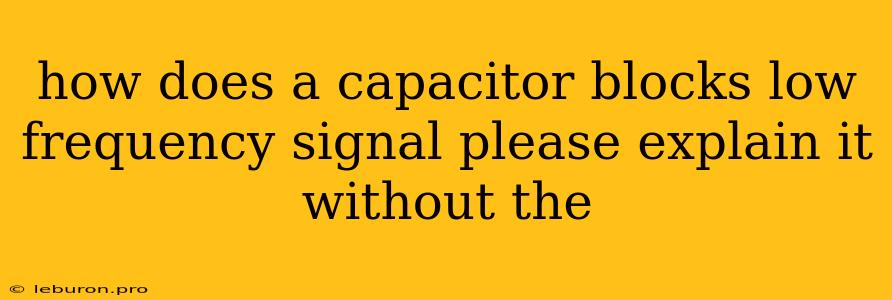Capacitors are essential components in electronic circuits, playing a crucial role in filtering and shaping signals. One of their fundamental properties is their ability to block low-frequency signals while allowing high-frequency signals to pass through. This behavior stems from the capacitor's inherent opposition to changes in voltage, a characteristic that becomes more pronounced at lower frequencies. Understanding how capacitors block low-frequency signals requires delving into their basic operation and the relationship between frequency and capacitive reactance.
The Fundamentals of Capacitance
A capacitor is essentially a device that stores electrical energy in an electric field. It consists of two conductive plates separated by a non-conductive material called a dielectric. When a voltage is applied across the plates, charges accumulate on their surfaces, creating an electric field. The ability of a capacitor to store charge is quantified by its capacitance, measured in Farads (F).
Capacitive Reactance: The Impedance to Alternating Current
When a capacitor is connected to a circuit carrying an alternating current (AC), it exhibits an impedance known as capacitive reactance (Xc). This reactance, measured in ohms (Ω), represents the capacitor's opposition to the flow of AC current. Capacitive reactance is inversely proportional to the frequency of the AC signal and the capacitance of the capacitor:
Xc = 1 / (2πfC)
Where:
- Xc is the capacitive reactance in ohms (Ω)
- f is the frequency of the AC signal in Hertz (Hz)
- C is the capacitance of the capacitor in Farads (F)
This equation reveals a crucial aspect of capacitor behavior: as the frequency (f) decreases, the capacitive reactance (Xc) increases. This means that at low frequencies, the capacitor presents a high impedance, effectively blocking the flow of current. Conversely, at high frequencies, the reactance is low, allowing current to pass through easily.
How Capacitors Block Low-Frequency Signals
To grasp the concept of a capacitor blocking low-frequency signals, consider the following:
- Low-Frequency Signal: A low-frequency signal changes slowly over time. This slow change in voltage across the capacitor allows charges to accumulate on its plates relatively easily, creating a large voltage drop across the capacitor. This voltage drop effectively "blocks" the signal from passing through.
- High-Frequency Signal: A high-frequency signal changes rapidly over time. This rapid change doesn't allow sufficient time for charges to accumulate significantly on the capacitor's plates. Consequently, the voltage drop across the capacitor remains small, allowing the signal to pass through with minimal impedance.
Think of it like a gatekeeper:
- Low frequency: The gatekeeper is slow to open and close. It prevents the low-frequency signal from passing through quickly.
- High frequency: The gatekeeper is fast and can readily open and close, allowing the high-frequency signal to pass through easily.
Practical Applications of Capacitor Blocking Low-Frequency Signals
The ability of capacitors to block low-frequency signals has numerous applications in electronics:
- Coupling Capacitors: In audio amplifiers, coupling capacitors are used to block DC signals from passing to the next stage, while allowing the desired audio signal to pass through.
- Bypass Capacitors: These capacitors are placed in parallel with components to provide a low-impedance path for high-frequency signals, bypassing the component and minimizing noise or interference.
- Filtering Circuits: Capacitors are crucial components in filter circuits, used to separate different frequencies in a signal. Low-pass filters utilize capacitors to block high-frequency signals, while high-pass filters use them to block low-frequency signals.
- Power Supply Filtering: Capacitors are essential in power supplies to smooth out voltage fluctuations and eliminate ripple, a low-frequency component in the output voltage.
Understanding the Trade-Off
It's important to note that capacitors are not perfect frequency-selective elements. While they are effective at blocking low frequencies, they do not completely eliminate them. At extremely low frequencies, the reactance of a capacitor can become so high that it effectively acts as an open circuit, blocking even the low-frequency signal.
The effectiveness of a capacitor in blocking low frequencies depends on factors like:
- Capacitance value: A larger capacitance value will have a lower reactance at a given frequency, making it less effective at blocking low frequencies.
- Signal frequency: Lower frequencies will be blocked more effectively than higher frequencies.
Therefore, choosing the appropriate capacitance value is crucial for achieving the desired filtering effect.
Conclusion
The ability of a capacitor to block low-frequency signals is a fundamental property stemming from the relationship between capacitive reactance and frequency. This property allows capacitors to be used effectively in various circuits for filtering, signal coupling, and noise reduction. Understanding how capacitors interact with different frequencies is essential for designing efficient and effective electronic circuits.
